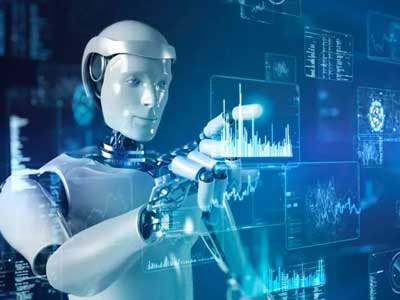Key Takeaway
Robotics is rapidly advancing with several potential breakthroughs. One major area is AI integration, making robots smarter and more autonomous. Natural interfaces and speech recognition will allow robots to interact more naturally with humans. The deployment of 5G technology will enhance robot connectivity and responsiveness. Big data is crucial for improving robot learning and performance. Additionally, context-awareness technology will enable robots to better understand and react to their environment. These emerging technologies will significantly enhance the capabilities of robots in various sectors.
AI and Cognitive Computing
AI and cognitive computing are revolutionizing industries by mimicking human thought processes to solve complex problems. These technologies analyze vast datasets, learn from patterns, and make decisions with minimal human intervention. From enhancing customer experiences to optimizing industrial processes, AI’s capabilities are reshaping businesses worldwide. Cognitive computing goes beyond traditional AI by incorporating human-like reasoning, understanding, and learning. Together, they pave the way for innovative applications in healthcare, finance, and beyond, promising smarter automation and decision-making capabilities for a more efficient future.

Advanced Materials
The development of advanced materials is revolutionizing the robotics industry. Innovations in lightweight, durable, and flexible materials are creating more efficient and versatile robots. For instance, carbon fiber composites and advanced polymers are making robots lighter and more energy-efficient. This reduction in weight translates to lower energy consumption, which is crucial for extending operational times and enhancing performance. Additionally, these materials can withstand harsh environments, making them ideal for use in extreme conditions such as space exploration or deep-sea missions.
Shape-memory alloys and soft robotics materials are also paving the way for more dexterous and resilient robots. These materials allow robots to mimic human-like movements and adapt to their surroundings with greater precision. Imagine a robot that can change its shape to squeeze through tight spaces or recover its original form after a deformation. This flexibility and durability will enable robots to perform tasks that were previously impossible, increasing their utility in various industries. These advancements are not just theoretical but are being actively integrated into modern robotic systems, showcasing the transformative potential of advanced materials.
Autonomous Systems
Autonomous systems are a cornerstone of modern robotics, enabling robots to operate independently without human intervention. These systems are equipped with sophisticated sensors, cameras, and advanced algorithms that allow robots to perceive their environment, avoid obstacles, and make real-time decisions. This autonomy is crucial for applications such as autonomous vehicles, drones, and industrial robots. For example, autonomous drones can inspect infrastructure, deliver packages, and even assist in search and rescue operations, all without needing a human pilot.
As these autonomous systems continue to evolve, robots are becoming more self-sufficient and capable of handling complex tasks. The integration of machine learning and artificial intelligence further enhances their decision-making capabilities, allowing them to adapt to new situations and learn from their experiences. This technological progression is reducing the need for constant human supervision, freeing up human workers to focus on more strategic and creative tasks. Ultimately, autonomous systems are transforming the landscape of robotics, making robots more versatile, efficient, and capable of operating in diverse environments.
Human-Robot Interaction
Enhancing human-robot interaction (HRI) is vital for the widespread acceptance and integration of robots into everyday life. Advances in HRI are enabling robots to understand and respond to human emotions, gestures, and commands more effectively. This is achieved through enhanced sensors, improved algorithms for speech and gesture recognition, and more intuitive user interfaces. Imagine a robot assistant that can recognize when you’re frustrated and adjust its behavior to be more helpful and supportive. This level of empathy and responsiveness is essential for robots to be truly useful in daily settings.
Improved HRI makes robots more accessible and user-friendly, expanding their applications in various fields. For instance, in healthcare, robots can assist the elderly or support individuals with disabilities, providing companionship and aid. In industrial settings, robots can work alongside human workers, performing collaborative tasks that enhance productivity and safety. The goal is to create robots that are not only functional but also empathetic and easy to interact with, fostering a seamless integration of robots into human environments. These advancements in HRI are making robots more relatable and useful, paving the way for a future where humans and robots coexist harmoniously.
Energy Efficiency Innovations
Energy efficiency is a critical focus in the development of modern robotics. As robots become more advanced and prevalent, reducing their energy consumption is essential for sustainability. Innovations in battery technology, energy harvesting, and power management systems are driving this transformation. For instance, new battery chemistries and energy-dense materials are providing longer operational times and faster recharging capabilities, making robots more reliable and efficient.
Additionally, technologies that enable robots to harvest energy from their environment, such as solar panels or kinetic energy systems, are further enhancing their efficiency. Imagine a robot that can recharge itself by capturing solar energy during the day or by converting its movements into electrical power. These advancements make robots more sustainable and cost-effective, reducing their environmental impact and operational costs. Energy efficiency is not just a technical improvement but a necessary evolution to ensure the long-term viability of robotic systems. By focusing on energy efficiency, we are paving the way for a future where robots can operate continuously and sustainably in various applications.
Conclusion
In envisioning future breakthroughs, staying at the forefront of industrial automation remains pivotal. Advancements in AI-driven predictive maintenance, enhanced IoT integration, and sustainable automation solutions promise transformative impacts. As we forge ahead, embracing these innovations will not only optimize operational efficiencies but also redefine industry standards. By fostering a culture of innovation and adaptation, IndMALL is poised to lead in shaping the next era of industrial automation.
